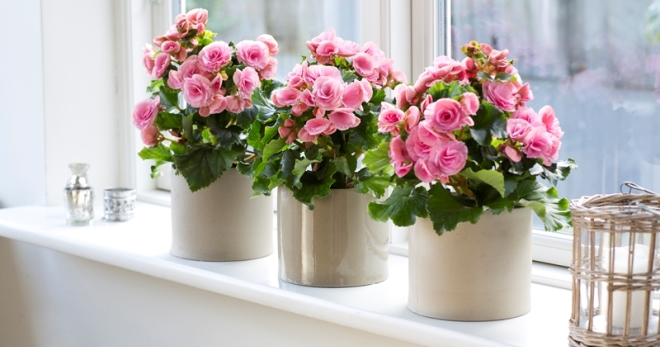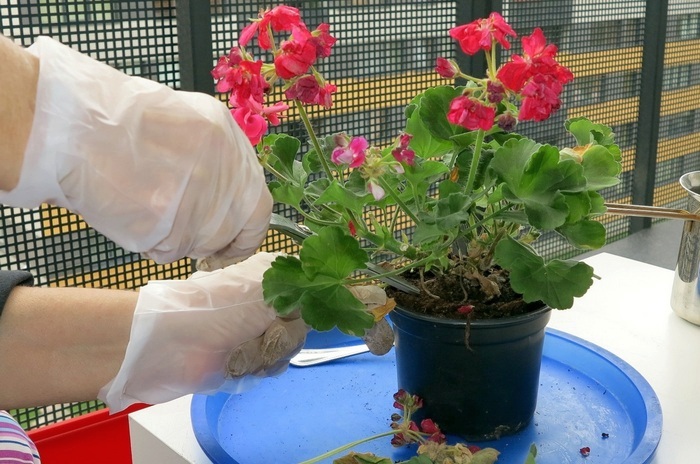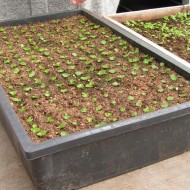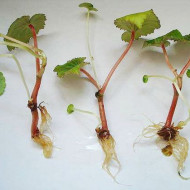How to care for potted begonia: tips from florists
Content
Types and varieties of begonias for home breeding
The homeland of "maiden beauty", as begonia is popularly called, is the subtropics, but it has long been decorating the gardens and window sills of flower growers in all countries of the world. The botanical directory has almost 800 species, from which breeders have bred about 2,000 varieties. They all fall into three categories:
- Eternal flowering. They are distinguished by a bright varied palette of shades. The most famous varieties: Volumia, Senator, Olomouc.
- Decorative deciduous. The visiting card of this group is large leaves of an unusual shape with an original color. Varieties popular among flower growers: Royal, Mason, Bauer.
- Tuberous. In summer, begonias are covered with large multi-colored flowers up to 15 cm in diameter. The most successful varieties are: Marmorata, Pikoti, Fimbriata.

Plant adaptation after purchase
So that after the purchase the begonia does not wither in a new place, you should follow a few simple rules:
- Avoid brightly lit areas. In the warm season, the northern side is suitable for the flower, and in autumn and winter it is better to put the flowerpot on the western or eastern window sills.
- Avoid drafts.
- Do not moisten the soil for the first five days. It is best to place a bowl of water next to the pot so that the begonia does not suffer from a lack of moisture.
- Do not transplant a new "pet" immediately after purchase, especially if it has already begun to bloom.
- Keep the flower away from other indoor plants for the first 14 days. Quarantine is essential to reduce the risk of infection with infections and insects.
Home Begonia Care Video
This video tells about the features of indoor flower care.
Optimal conditions for home growing
Breeding "girlish beauty" is a simple process, but it requires certain conditions.
Lighting
Daylight hours for an indoor flower should last 12-14 hours a day. Placing a flowerpot on a light window, it is shaded with blinds or newspapers. In winter, when there is not enough daylight, special phytolamps are installed that give diffused light.

Temperature
Begonia does not like sudden changes in temperature. In the warm season, begonia feels comfortable at + 20 ... + 22 ° С. In autumn and winter, it is better to lower the degree to + 15 ... + 19 ° С. If the indicator is less or more, the flower will begin to wither, shed its leaves, and may even die.
Humidity
The cultivation of "girlish beauty" also requires a high level of humidity (60-80%). In order for the moisture-loving plant to grow well, the flower pot is placed on wet fine gravel or expanded clay. Place a bowl of water, an aquarium, or a humidifier nearby.
Flower pot and soil
Begonias grow best in round ceramic pots with drainage holes. It is impossible to grow a flower initially in a large pot, since there is a risk of developing root rot. As they grow, the dimensions of the containers must necessarily change:
- for a young seedling, a diameter of 5–6 cm is enough;
- six months later, the matured plant is transplanted into a larger pot (8–10 cm);
- a year later, the volume is increased by a third from the previous one.
The indoor flower prefers a nutritious, light soil with good carrying capacity. The acidity should be at pH 5.5. Before use, the substrate is calcined in the oven to kill pathogenic microorganisms.
Rules for caring for begonia at home
Even a beginner in floriculture will be able to take care of the "girlish beauty". It is enough just to adhere to simple rules.
Watering and feeding
A tropical flower needs abundant and regular watering. From early spring to late autumn, it is moistened every three days, preventing the substrate from drying out more than 1.5 cm. In extreme heat, the procedure is carried out daily. In winter, watering is reduced to 1 time per week. For irrigation, use soft purified water at room temperature.

Fertilize begonia every 15 days, from the budding period to the end of flowering. Eternal flowering varieties are fed with potassium-phosphorus compositions, and decorative deciduous varieties prefer nitrogen-containing preparations.
Pruning
Experienced growers recommend pruning in two stages:
- When the shoots of a young plant are 6-7 cm long.
- When the lateral shoots reach a length of 10 cm. They are cut off to the upper bud, and unnecessary shoots are also removed to form the correct crown.

Winter care
Caring for evergreen and ornamental leafy begonias in winter is practically the same as in summer. The flower is provided with additional lighting, the temperature is lowered, watering is reduced, and it is removed away from the batteries. In specimens that bloom all year round, pinch the tops of the shoots.
Tuberous varieties are dug out before wintering. The bulbs are well dried, and then covered with sand or peat. It is best to store them on the balcony or in the basement, periodically checking for negative phenomena.
Features of transplantation and reproduction
Some growers prefer to propagate the "maiden beauty" themselves. They grow an indoor flower from seeds, cuttings, or detach from a donor plant.
Seeds
Planting material for seedlings begins to be sown from the end of February - beginning of March. It is scattered over the surface of the substrate, without falling asleep from above with soil. The containers are covered with plastic or glass and placed in a lighted place in a warm room. When the soil dries up, it is moistened with a spray bottle.
The first pick is carried out after the appearance of 2-3 leaves. The procedure is repeated after another 2 months, after which the seedlings are planted in separate pots.
Cuttings
A twig 7–8 cm long is cut off from an adult plant. The lower leaves are removed, leaving only 2–3 upper leaves, which are slightly trimmed. Sprinkle the cut sites with an antiseptic and insert the shoot into the soil. Cover the seedling on top with a plastic bottle or jar. Begonia will begin to bloom within 2 months after planting.
To prevent the cutting from suffocating, it must be regularly ventilated.
Dividing tubers and bush
The method is only good for bush varieties. The donor bush is carefully dug out, the rhizome is soaked and cut into pieces. Dried leaves, faded parts, damaged areas are removed from the shoots. Places of cuts are sprinkled with activated carbon, and then seated in separate flowerpots.
- Seeds
- Cuttings
- By dividing the sheet
Dangerous pests, diseases and other problems
To keep begonia healthy, you need to regularly check the flower for diseases or pests. Symptoms noticed in time are much easier to eliminate than to treat an advanced form. Most often, the plant is susceptible to:
- rot (gray, black, brown);
- botrytis;
- powdery mildew.
Targeted fungicides or Bordeaux mixture can help cope with pathogenic fungi.
Plants affected by a bacterial infection are dug up and destroyed.

Also insects often appear on begonias:
- aphid;
- mite;
- nematode.
You can get rid of pests with the help of Actellik or Karbofos.
If no signs of infection or parasites are found, and the flower dries up and sheds leaves, then the reason may lie in too dry air or insufficient watering. If the temperature is too low and moisture stagnates, yellow spots may appear on the sheet plates.
Sometimes it happens that the "girlish beauty" stops blooming. There may be several reasons for this:
- bad light;
- stagnant moisture;
- drying out of the soil;
- temperature drops;
- irregular feeding;
- insect pests;
- continuous flowering before;
- unsuitable flowerpot size;
- drafts;
- frequent change of places.
If, after correcting the problems, flowering still does not come, then you can force the flower to "wake up" forcibly. For this:
- pinch the plant;
- reduce daylight hours to 9 hours, until buds begin to form;
- feed with complex formulations;
- increase daylight hours to 18 hours.
Don't be afraid to grow begonias at home. It is enough to provide the plant with the necessary care so that it reciprocates with you.



